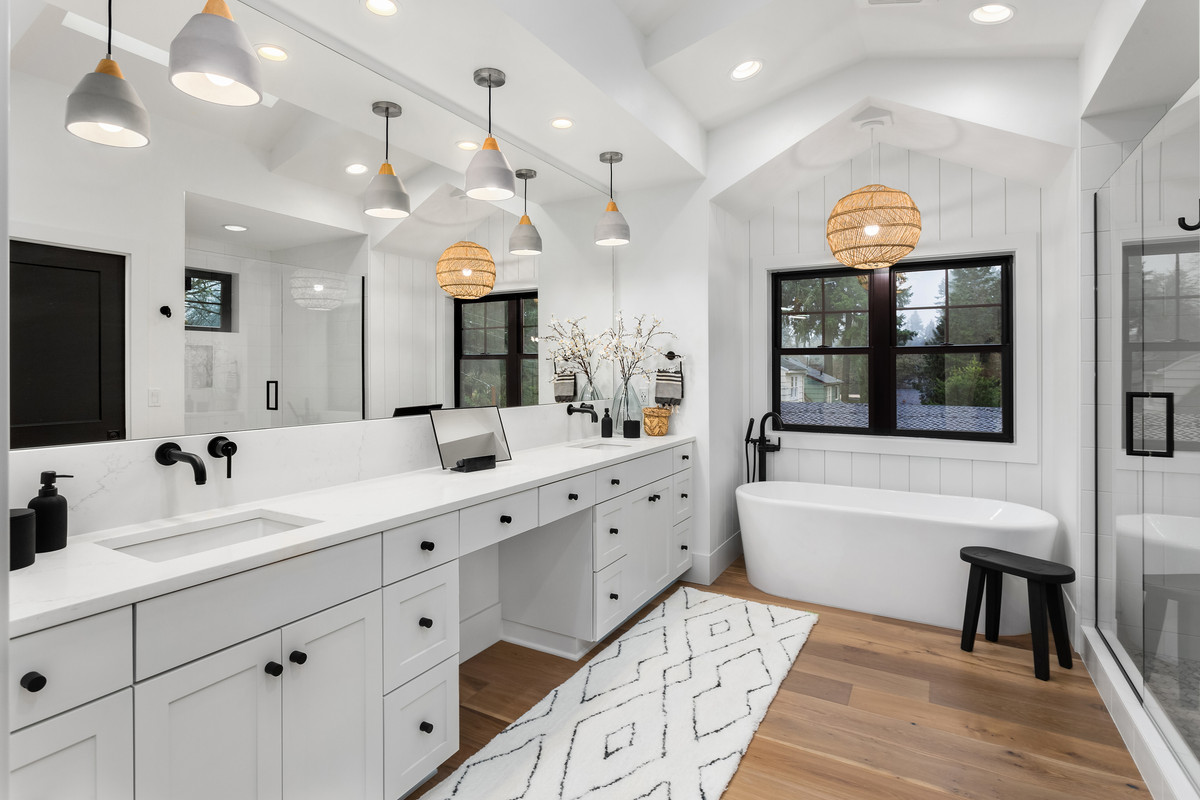How Much Should You Spend on Bathroom Remodeling?
by siteadmin

Whether your home needs a makeover or you need to make repairs, there is no better time than now to take the plunge. A few simple improvements can make a huge difference, from installing wider drainpipes in baths shared by more than one person to adding grab bars and blocking for grab rails between wall studs if your walls are open. Adding a soaker tub to a traditional bathtub can also require an upgraded water heater. A bathroom can also be the source of a myriad of plumbing issues, from replacing a faulty flapper or re-anchoring a towel bar.
Costs of bathroom remodeling
The costs of bathroom remodeling vary depending on what you want to change. While structural changes can drive up the costs, many homeowners can opt to make only cosmetic changes. This way, they can get a decent-looking bathroom for a reasonable price. Here are some tips to help you determine how much you should spend on your bathroom remodel. First, determine the purpose of your remodel. Do you simply want to make it more attractive or do you want to add more functionality?
The cost of bathroom remodeling is largely determined by the type of materials and labor involved in the project. However, there are also a variety of other factors that affect the price. Some elements are necessary while others can be tailored to fit your budget. By comparing prices, you can find which elements are necessary and which ones can be eliminated. Custom products can be an excellent choice if they fit your budget and aesthetic requirements. If you can't afford to hire professionals, try saving money by remodeling just a portion of your bathroom.
New fixtures can transform the appearance of a bathroom. You can purchase new ones at home improvement stores or online. Keep in mind that you should choose the same or slightly larger footprint than your old fixtures. Also, be sure to consider the plumbing connections as they may increase the cost. While new fixtures can add a few hundred dollars to your budget, they can add up to thousands. Choosing a high-quality bathroom fixture is essential for maximizing the look of your bathroom.
Next, decide what materials you would like to use for your bathroom remodeling project. Choose from natural stone, polished granite, or intricate tiles to get a better idea of what you can afford. Prices of bathroom remodeling are affected by the type of materials used and the timing of the project. The worst time to start a project is summer when demand for materials increases. Therefore, it is best to start the project in the spring, when materials are cheaper. Winter, however, can affect the quality of the materials and workers.
Materials used in bathroom remodeling
There are endless choices when it comes to materials used in bathroom remodeling. Cabinets can be added to create storage space and provide a decorative surface. Paint should complement the overall style of your home, whether it's a soft white, delicate gray, or a bright yellow or baby blue. Luckily, you don't have to spend an arm and a leg on new paint to update your bathroom. If you're on a budget, you can install paneling over old, cracked tile.
Countertops should be durable and easy to clean. Porcelain and stone surfaces become slippery and warp if they are exposed to moisture, while carpets tend to harbor mold and damage the floor underneath. Quartz and other waterproof materials are popular countertops. Laminate and solid surface countertops are also available. If you're tired of your old, dated cabinets, you can also consider resurfacing. These two options can drastically improve the look of your bathroom.
Ceramics are another popular material for bathroom remodeling. Ceramics are durable, scratch-resistant, and fit in most bathroom settings. If you're looking for a small soap dispenser, ceramic is a great choice. Ceramic wall tiles make a great shower wall, too, and look good when mixed with other colors. Tile is a good choice for walls, too, and guarantees a moisture-resistant surface. It's also inexpensive and versatile.
Before you begin your bathroom remodeling project, you need to remove any old plumbing. You'll also need to check the walls for damage. If there's any damage to them, you'll need to replace them. It's important to note that replacing walls isn't always easy. However, cement walls are generally tougher than wood ones. And if you do decide to install tile, make sure to match the color of the grout to the tile.
Bathroom walls should be made of durable material. You'll want to choose ceramic, granite, or stone tile to avoid cracks, as these materials are waterproof. You can also opt for paint, but stick to the basics – matte colors are great if your bathroom is small. A free-standing tub is an excellent option if you have more space. If you're remodeling a small bathroom, a shower/tub combo is a great option.
Time frame for completing a bathroom remodeling project
The time frame for completing a bathroom remodeling project can vary from a couple of weeks to several months, depending on the scope of the work. A small renovation may take less than a week if the contractor merely installs new fixtures. A full bathroom remodel, however, may take months or even a year if it involves ripping out the entire bathroom and changing its layout. If the contractor guarantees to complete a project in less than a week, beware. If he promises to do the entire job in just a week, they're probably cutting corners.
After you've agreed on a design and price, the contractor will typically start demolition and install the new cabinets. Plumbing and electrical work are usually completed after demolition. Once these are completed, the contractor will return to the site to complete the painting and prep work. The countertop template, meanwhile, will be installed, and the project will be complete by the time the contractor is finished. Timeframe for completing a bathroom remodeling project depends on the extent of the work.
Typically, plumbing, electrical wiring, and flooring installations will take a week or two. During this time, rough carpentry, plumbing, and electrical installation will take a few days. Next, insulation and drywall will be installed. The last two weeks will be devoted to installing new fixtures and finishing touches. A bathroom remodel can take two to three months if the work is done correctly. But keep in mind that delays can occur and some do-overs may be necessary.
Choosing the right contractor is crucial to the success of your bathroom renovation. If you rush a bathroom remodeling project, you may end up with a substandard design, cost overruns, and costly repairs. Rushing a bathroom renovation can also lead to missed opportunities, missed material deliveries, and improper worker checks. Ultimately, a bathroom remodeling project can be stressful and time consuming, so a little research and planning will go a long way.
Sub-projects involved in bathroom remodeling
When you are looking to remodel your bathroom, it is essential to understand the various sub-projects. You can save about $500-600 by doing the work yourself. However, you must be aware of the things that may cause problems for your contractor. Tile installation is one of those things. Do-it-yourself tile installation is not for the faint of heart. Despite its convenience, it can take up to twice as long as hiring a professional. Additionally, it might not look as professional as hiring a pro.
A typical bathroom in a Seattle home is approximately five feet by eight feet and forty square inches. While materials for this space are relatively inexpensive, skilled labor makes up a large portion of the total project costs. In addition to the materials used, each trade also incurs a minimum cost for bids and equipment. Once hired, they may return one or two times to complete the project. The entire process can take between eight to twelve weeks.
The largest sub-project of a bathroom remodeling project involves installing the shower, bathtub, and tile. Tile work can take several days or a week to complete. Once tile work is complete, it is time to paint the walls. Bathroom walls are painted with satin or semi-gloss paint that protects them from moisture. In addition to painting, a bathroom remodel may include installing new fixtures and fittings. While this task isn't as complex as re-painting a whole house, it can be a huge hassle.
The cost of a bathroom remodeling project is substantial. On average, 50 to 75 percent of the total project cost is labor. Using a professional contractor will streamline this process by coordinating all sub-projects, ensuring that everything is done on time and with quality materials. Additionally, the contractor will handle all the necessary permits for the project and will provide a warranty on the work. The cost of a bathroom remodel can easily increase.
Bathroom remodeling projects may require significant plumbing changes. The cost of relocating the plumbing is the biggest difference-maker when it comes to cost. It's already the most expensive sub-contractor in bathroom remodeling, but the added expense of relocating the plumbing can drive up costs significantly. If you plan to move plumbing or replace the entire bathroom, you'll have to budget more and include more contingency. And don't forget to think about the cost of plumbing!
Category: Bathroom Remodeling
Tags: bathroom remodeling, bathroom renovation, bathroom remodeler, remodeling contractors, remodeling,
Whether your home needs a makeover or you need to make repairs, there is no better time than now to take the plunge. A few simple improvements can make a huge difference, from installing wider drainpipes in baths shared by more than one person to adding grab bars and blocking for grab rails between wall…
Recent Posts
- Leveraging Technology for Accessible Real Estate Investing: A Deep Dive into Robinhood REI
- Green Lawns Solutions Presents: The Benefits of Professional Lawn Service for Orlando Residents
- Budget-Friendly Lawn Service Options in Orlando: Quality without Breaking the Bank
- Bridging the Gap: The Availability of Mental Health Providers in Wyoming
- Interest Rate Risk Management for Financial Institutions in Wyoming
